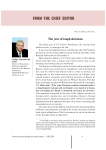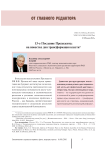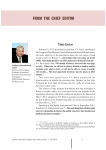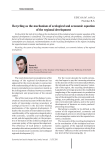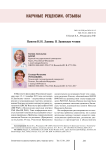Economic and Social Changes: Facts, Trends, Forecast @volnc-esc-en
Статьи журнала - Economic and Social Changes: Facts, Trends, Forecast
Все статьи: 1728
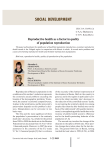
Статья научная
Importance and role of small enterprises during the transition of northern regions to innovation development are determined. Condition, problems and development prospects of small innovation entrepreneurship are considered. Proposals on improvement of the system of governmental support and conditions, influencing survival and development of small enterprises are worked out.
Бесплатно
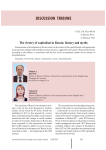
The victory of capitalism in Russia: history and myths
Статья научная
Interpretation of development of Soviet society in the context of the capitalization with appropriate social and class changes (the emergence of new classes) is suggested in the article. Postsovetsky period, according to the authors, is associated with the loss of the accumulated capital of our country or decapitalization.
Бесплатно
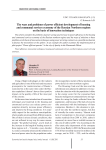
Статья научная
The article considers the problems of power savings and increase in power efficiency in the housing and communal services economy of the Russian northern regions and the ways of solutions to these problems on the basis of innovation techniques using power servicing contracts as a possible mechanism to finance the investments in this sphere. As an example the author examines the implementation of pilot project “Power efficient quarter” in the city of Apatity in the Murmansk Oblast.
Бесплатно
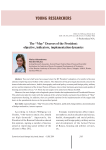
The “May” decrees of the president: objective, indicators, implementation dynamics
Статья научная
Two and a half years have passed since the RF President’s adoption of a number of decrees aimed at improving social welfare of the citizens. The objectives of the given legal documents concern the issues of education and science, health, demography and social policy, economy and foreign policy, military service and development of the Armed Forces of Russia, inter-ethnic harmony, governance and quality of housing and utility services. V.V. Putin has set targets to be achieved in Russia by 2020. However, the acute budget crisis of regional systems hinders the implementation of Presidential Decrees.This article provides the reader with the analysis of the achieved results and states the problems of “May” requirements funding. In addition, there are possible options for the implementation of the targets laid down in the presidential decrees in the prescribed period.
Бесплатно
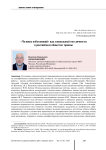
The “avoidant individual” as a social personality type in the Russian Trauma Society
Статья научная
In the context of socio-cultural traumatization of Russian society, specific social personality types are formed, which require the attention of researchers. The aim of the work is to analyze the “avoidant individual” as a social personality type. The methodological basis of the work includes the theories of trauma society (J. Alexander, P. Sztompka, Zh.T. Toshchenko) and the anthroposociocultural approach (anthroposociocultural evolutionism; N.I. Lapin). We used general scientific methods: analysis, synthesis, generalization, induction, formalization, idealization, typologization, generalization, analysis of scientific literature, secondary data analysis. The results obtained and the novelty of the study are as follows: we were the first to demonstrate the heuristic potential of using Zh.T. Toshchenko's theory of trauma society and N.I. Lapin's anthroposociocultural approach to develop a concept of the “avoiding individual” as a social personality type in a trauma society; we showed the possibility of using a crucial protective mechanism - avoidance of traumatic situations experienced by an individual - as a basis for identifying a specific social personality type “avoidant individual”; we defined its features that are formed under the influence of trauma society: high anxiety, lack of a clear image of the desired future, value orientations on material well-being, career, family, health, hedonism, a tendency toward antisocial behavior. It is the presence of post-traumatic motivation, which underlies the value orientations manifested by the respondent, that acts as a criterion for classifying a person as belonging to this social type. The findings of the research can be used for the development of sociological theories of personality, sociology of culture, sociology of management, sociology of social change. It is of practical importance to study the distribution of this type of personality in various social groups, strata and regions of the country. One of the important areas of future research is to analyze the influence of representatives of this type of personality on the social processes taking place in Russian society.
Бесплатно
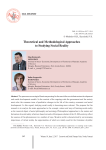
Theoretical and methodological approaches to studying social reality
Статья научная
The processes occurring in Russia are pressing for the search for new infrastructure development and social development models. In the context of the ongoing crisis the government and the society must solve the common issue of qualitative changes in the life of the country, economic and social development. In this regard, studying social reality is becoming more relevant. The purpose for this research is to analyze the main approaches to the concept, nature and ways of forming social reality as the research object of social philosophy and sociology. Philosophical approaches to the nature and formation of social reality, which are based on works of European scholars of the 19-20th century, reflect the essence of this phenomenon in a number of ways. Modern world is characterized by an increasing importance of virtual reality, the opportunities of which are widely used for the formation of public consciousness. According to analysis results, profound sociological study of social reality requires the use of achievements of all philosophical schools and approaches. Without their integration, the image of social reality will be one-sided, which will make in impossible to apply the research results for effective social management.
Бесплатно

Статья научная
He article proposes certain methodological approaches to the formation of conditions for the development of innovation clusters, aimed at the structuring, appraisal and promotion of innovation processes. The article highlights some efficient conditions for the formation and development of “ideal” innovation clusters on the basis of these approaches.
Бесплатно
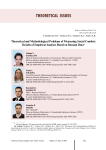
Статья научная
The research is aimed at developing theoretical aspects of the latent category “social comfort”, searching for new assessment methods and opportunities for using various types of information resources (big data, continuous and sample population surveys, state and administrative statistics). Development of the axiomatics of a new category and its modeling are necessary to determine a real level of population's well-being in dynamics, to assess true quality of people's life. The purpose of the research is aimed at development of theoretical and methodological foundations of social comfort as a latent category in the discourse of social processes and the test of its assessment using the method of generalized principal components. The main results of the study include the clarification of connotations and development of axiomatics for the new category “social comfort”; systematization of relevant international surveys, and the formation of reliable categories that ensure the validity of the results; assessment of the level of social comfort using the method of generalized principal components for a space-time sample - the STATIS method. The peculiarity of the method, used for space-time sampling, is an opportunity to simultaneously study object-feature matrices, related to different time points, and the identification of the parameters that mostly determine the scattering of observation objects: in our case, the regions of the Russian Federation, on a plane of main components of the generalized (compromise) space. The scientific novelty of the research is development of the axiomatics of the new category “social comfort”, which allows measuring and studying a person from the point of view of his inclusion in society, semantic correlation of various types of activity with time and external situation, expanding the subjective aspect of measuring the quality of life as one of the most important categories of social and economic science; the formation of new approaches to modeling and evaluating social comfort. The study is of practical interest to researchers, and its results may be used for creating socio-economic development programs in Russian regions.
Бесплатно

Статья научная
The article raises the issues of motivation in the context of individual approaches (Freudian, behavioral, cognitive-psychological, etc.) in the framework of theoretical-personal and theoretical-associative fields. The goals of the article are as follows: to structure the main existing approaches to the study of motivation, and to determine the provisions that can be used in the framework of the motivation for people’s creative labor activity. The study used general logical methods and techniques, such as system approach, generalization, analysis, and synthesis. We conclude that the main source of people’s activity is need-based tension, and the aim is to eliminate it using external incentive factors. We show that the nature of behavior will be determined by the degree of consistency between different groups of motives, correlation of motives and external goals, and in the absence of such coordination - by volitional mechanisms of regulation. We point out that scientific literature contains no unambiguous definition of motivational-stimulating mechanism; the paper provides its interpretation from the standpoint of behavioral approach and A.N...
Бесплатно
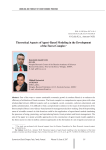
Theoretical aspects of agent-based modeling in the development of the forest complex
Статья научная
One of the ways to ensure sustainable economic growth in modern Russia is to enhance the efficiency of utilization of forest resources. The forest complex is a comprehensive open system with close relationships between different aspects such as ecological, social, economic, cultural, educational, and public administration. It is difficult to find a comprehensive solution to the issues of development of the forest complex if there is no evidence-based system for management decision-making. One of the promising areas of scientific research in this direction could be the application of agent-based models simulating the processes of using, protecting, and reproducing forests, forest products and forest management. The aim of the paper is to study scientific approaches to the construction of agent-based models applied to the forest sector in order to define common approaches to the formation of a set of agents and create an environment for their functioning. We provide an overview of the experience of simulation modeling of individual processes in the forest complex with the use of the agent-based approach...
Бесплатно
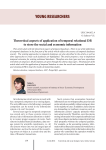
Статья научная
This article deals with the theoretical aspects of temporal databases. There is one of the definitions of temporal databases in the first part of the article which reflects the essence of temporal databases exactly. The existing approaches to temporal databases are also described in the article as well as three approaches to create such databases are highlighted. The article proposes a way to implement temporal extension for existing relational databases. Therefore new data types and new operations with them are proposed. All descriptions are given through the abstract data types. The final part of the article deals with the application of temporal database to store the social and economic information and creating of DB to keep the results of monitoring studies.
Бесплатно
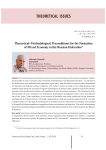
Статья научная
The article presents the author's point of view on the formation of the mixed (convergent, double-track) model of socio-economic and community development in the Russian Federation - as inherent in the federal state with multinational population, open space, and diversified economic orders determined by historical and national-cultural traditions. The author's stance is based on the wildly discussed and debated thesis about the necessity of organic combination of primary state regulation of macroeconomic processes with predominant market self-regulation of microeconomic processes. The framework of the mixed model of socio-economic and community development presupposes more active and effective use of the “point” state regulation in the creation of favorable and equal conditions for the systematic development of all forms (private, with public participation) of business and the expansion of the “corridor of opportunities” for the spatial development of all regions and the improvement of quality and standard of living of the Russian population (regardless of place of residence and position). The article substantiates theoretical and methodological possibility of successful implementation of the mixed model in the Russian Federation.
Бесплатно
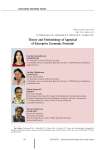
Theory and methodology of appraisal of enterprise economic potential
Статья научная
The functioning of an enterprise is based on building and use of its economic potential. The company's performance depends on the quality of these processes. Modern conditions of highly dynamic operating environment put demands on the search and application of new approaches to the building and use of economic potential of enterprises which provide opportunities for identifying and using internal economic growth reserves. An important economic parameter of the enterprise operation is the appraisal of economic potential formation and use effectiveness. Lack of economic control mechanisms scientifically proved for market management conditions and appraisal of the enterprises' state in terms of efficiency of economic resources formation and use diminish investment activity and the competitiveness of economic entities. This necessitates the search for new methods and models for appraising economic potential, which defines economic independence as a system of management impacts on the economic state and development of an enterprise...
Бесплатно

Threats to the region's economic security and the ways to overcome them
Статья научная
The paper summarizes the approaches to the definition of the category “economic security of the region”, gives its author's interpretation. The main threats to economic security are defined, the characteristic of their manifestation is presented. An analysis of major trends of socio-economic development of the Vologda oblast for the period from 2000 to 2009 is carried out, the most obvious threats to its economic security are revealed. The problems of regional economic policy the solution of which is aimed at ensuring economic security in the region are formulated.
Бесплатно
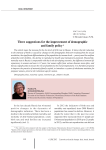
Three suggestions for the improvement of demographic and family policy
Статья научная
The article states the reasons for the low level of birth rate in Russia. It shows that the reduction in the intensity of births is caused by changes in the demographic behavior resulting from the sexual revolution, the significant differentiation of the population by income levels - poverty and low welfare of families with children, the decline in reproductive health and reproductive potential. Meanwhile, mortality rate in Russia is comparable with that in the developing countries; the difference between life expectancy in women and men is 12 years, but women suffer from various diseases more often, and this fact significantly increases the risk of disability by the end of employment. It is therefore proposed to improve the practice of maternity/family capital, to introduce a system of wholesome nutrition for pregnant women, preserve the retirement age for women.
Бесплатно

